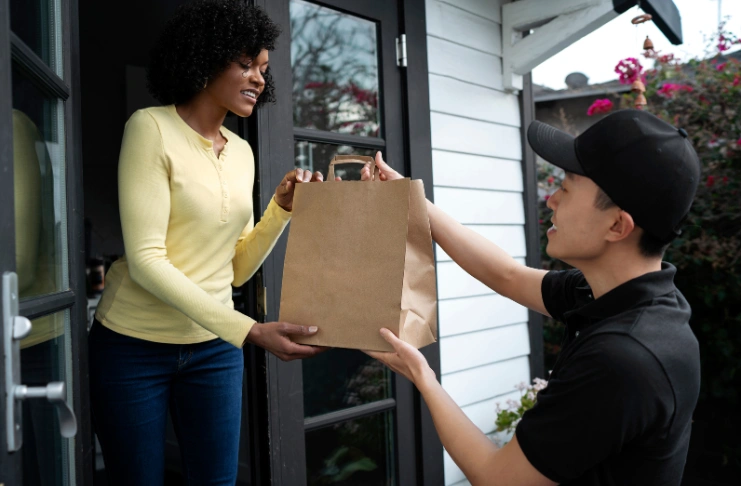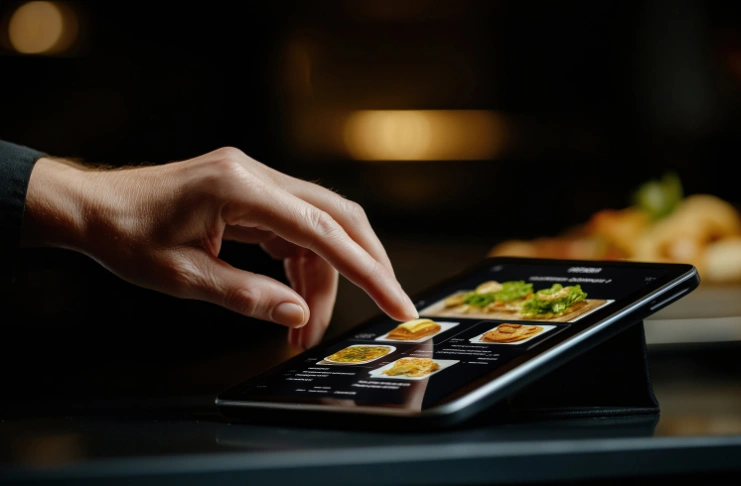Thinking about starting a takeaway business in the UK? Get ready for a fun and rewarding journey into the world of food entrepreneurship! With the meal delivery sector expected to reach $507 billion by 2029, the appetite for quick, delicious meals is stronger than ever. Whether you’re passionate about gourmet burgers, sushi, food trucks, or plant-based delights, there’s room for creativity and innovation.
This comprehensive guide is meticulously crafted to provide aspiring entrepreneurs with an in-depth roadmap to launching and sustaining a successful takeaway business. From understanding market nuances to navigating complex regulatory landscapes, we’ll explore every critical aspect of establishing a thriving food service venture.
So grab your apron, fine-tune your recipes, and get ready to dish out something amazing—your future customers are already hungry!
Understanding the UK Takeaway Market Landscape

The UK takeaway market is a complex and ever-evolving industry influenced by economic shifts, changing consumer habits, and technological advancements. Unlike traditional restaurants that rely heavily on dine-in traffic, takeaway businesses benefit from lower overhead costs, greater operational flexibility, and the ability to adapt quickly to external challenges.
During economic downturns, consumers often seek affordable and convenient meal options, making takeaways a cost-effective alternative to dining out. Moreover, global disruptions like the COVID-19 pandemic accelerated the adoption of online food delivery services, as lockdowns and social distancing measures forced restaurants to pivot towards takeaway and delivery models. This led to the rapid expansion of third-party platforms such as Deliveroo, Uber Eats, and Just Eat, which have revolutionized the industry by providing seamless ordering experiences and wider accessibility to consumers.
Additionally, innovations such as ghost kitchens (delivery-only restaurants) and the rise of contactless payment systems have further transformed the sector, making it more resilient and adaptable in an increasingly digital economy.
The UK’s food delivery market has experienced significant growth, reflecting profound shifts in consumer behavior. The market is valued at US$455.70 billion in 2025. This valuation isn’t merely a number but a reflection of profound shifts in consumer behavior. This growth is driven by factors such as urbanization, increased work pressures, technological advancements, and evolving social structures.
These elements have collectively fueled the expansion of takeaway services, making them an integral part of the UK’s food service industry.
Key market drivers:
- Rising digital literacy – As technology continues to evolve, more people are becoming comfortable with digital platforms, making online food ordering second nature. The ease of browsing menus, placing orders, making digital payments, and tracking deliveries has significantly improved the customer experience.
With digital wallets, contactless payments, and AI-driven chatbots assisting with orders, the food delivery process is now more seamless than ever. This shift has also encouraged takeaway businesses to invest in mobile-friendly websites, user-friendly apps, and automated customer support to enhance convenience and engagement.
- Increased smartphone penetration – With smartphone ownership rising globally, food delivery apps have become a household essential. Whether it’s a student ordering a late-night snack, a working professional grabbing lunch, or a family enjoying a weekend feast, the ease of ordering food with just a few taps has revolutionized the takeaway industry.
The availability of location-based services, push notifications for discounts, and AI-powered recommendations based on user preferences have made food delivery apps more engaging and effective. This has led to a surge in app-based takeaway businesses, pushing traditional restaurants to adopt digital strategies to stay competitive.
- Growing preference for convenience – Modern consumers prioritize speed and ease in their daily lives, and food delivery perfectly caters to this need. With demanding work schedules, long commutes, and busy personal lives, people are increasingly opting for quick, hassle-free meal solutions.
Takeaway businesses that offer fast delivery, pre-order options, and meal subscription services are gaining traction. Additionally, innovations like pre-packaged meal kits, heat-and-eat options, and AI-powered order tracking have made food delivery even more attractive, saving customers time while ensuring quality.
- Diverse culinary expectations – The UK’s food scene is becoming more global, with consumers eager to explore new flavors beyond traditional fast food. The demand for authentic world cuisines—Thai, Korean, Mexican, Middle Eastern, and plant-based options—has pushed takeaway businesses to diversify their menus.
Customers are now looking for healthier alternatives, allergen-friendly meals, and fusion cuisines that offer unique tastes. To stay competitive, businesses must introduce creative, high-quality menu options, ensuring they cater to both mainstream and niche dietary preferences.
- Evolving workplace cultures – The shift toward hybrid and remote work models has transformed consumer eating habits, particularly during lunch hours. With more people working from home, the demand for food delivery during traditional office lunch breaks has risen. Employers are also exploring corporate meal plans and virtual lunch perks to accommodate remote teams.
Additionally, evening orders have surged as professionals prefer to unwind with a convenient, restaurant-quality meal without the effort of cooking. Takeaway businesses that offer customized meal plans, subscription-based office lunches, and loyalty programs for repeat customers are well-positioned to support new business owners and capitalize on this growing trend.
Types of Takeaway Businesses

1. Traditional Cuisine Takeaways
Traditional takeaways represent the foundational layer of the UK’s food delivery ecosystem. These establishments, often family-run businesses, have been integral to local communities for decades.
Fish and chip shops, which have been British culinary institutions since the late 19th century, continue to thrive by adapting to modern consumer preferences. Many have successfully integrated online ordering systems and expanded their menu offerings while maintaining traditional preparation methods. Successful traditional takeaways share common characteristics:
- Consistent quality: Delivering high-quality food consistently builds trust and customer loyalty. Maintaining freshness, portion sizes, and presentation ensures a great experience with every order. Investing in standardized recipes, quality ingredients, and efficient packaging helps uphold brand reputation, encouraging repeat customers and positive reviews that drive long-term success.
- Strong community connections: Engaging with the local community fosters brand loyalty and boosts visibility. Partnering with local suppliers, participating in events, supporting charities, and offering special promotions help establish trust. Actively interacting with customers on social media and responding to feedback also strengthens relationships, making the business a valued part of the neighborhood.
- Adaptable menu offerings: Consumer preferences and food trends evolve, so regularly updating the menu keeps the business relevant. Offering seasonal specials, dietary-friendly options (vegan, gluten-free), and customizable meals caters to diverse tastes. Monitoring customer feedback and analyzing sales trends help identify what works, ensuring the menu remains appealing and profitable.
- Competitive pricing strategies: Balancing affordability with profitability is key to staying competitive. Utilizing dynamic pricing, value meal combos, loyalty discounts, and bundle deals attracts price-conscious customers while maintaining healthy margins. Partnering with delivery platforms, optimizing portion sizes, and sourcing cost-effective ingredients allow businesses to offer competitive prices without compromising on quality.
2. Specialty and Niche Takeaways
The emergence of specialty takeaways reflects the increasingly sophisticated palates of UK consumers. These businesses differentiate themselves through unique value propositions:
- Vegan and plant-based cuisine: The growing demand for sustainable, cruelty-free dining has fueled the rise of vegan takeaways. These businesses offer innovative plant-based alternatives like jackfruit tacos, lentil burgers, and dairy-free desserts, appealing to both vegans and flexitarians. Using organic, locally sourced ingredients and eco-friendly packaging enhances their appeal. Social media trends and celebrity endorsements have further boosted interest, making plant-based takeaways a thriving niche in the UK’s food industry.
- Healthy meal preparation services: Health-conscious consumers seek convenient yet nutritious meal options, leading to the rise of meal prep takeaways. These businesses focus on calorie-controlled, protein-rich, and balanced meals tailored for busy professionals, fitness enthusiasts, and weight-conscious individuals. Offering pre-portioned, fresh, and preservative-free meals with customizable options ensures sustained demand. Subscription-based meal plans and doorstep delivery services further enhance customer convenience and retention.
- Fusion food concepts: Fusion takeaways creatively blend global flavors, offering customers unique, unexpected combinations like sushi burritos, Indian-Mexican tacos, or Korean BBQ pizza. These businesses attract adventurous foodies looking for novel dining experiences. Social media plays a key role in their popularity, with visually appealing, Instagrammable dishes helping to drive organic marketing and customer engagement.
- Dietary-specific menus (gluten-free, keto, etc.): With increasing awareness of food intolerances and specialized diets, dietary-specific takeaways cater to consumers with gluten-free, keto, paleo, and allergen-friendly options. These businesses ensure strict adherence to dietary requirements while maintaining taste and variety. Clear labeling, transparency in ingredients, and collaboration with nutritionists build trust among customers, making them a go-to option for those with specific dietary needs.
Case Study:
Located in Cookham, Malik’s Express Kitchen is part of a family-run chain that has achieved significant acclaim in the UK culinary scene as a niche takeaway. The restaurant was named the Best Takeaway in the UK at the British Curry Awards, marking its seventh win at these prestigious awards.
Owned by Malik Ahmed and his family, the chain has expanded to multiple locations, including Marlow and Gerrards Cross, and is favored by celebrities such as Dragons’ Den entrepreneur Peter Jones and chef Heston Blumenthal.
Their success highlights how specialty and niche takeaways are reshaping the market, making them an excellent choice for a standout takeaway brand.
Steps to Start a Takeaway Business in the UK
Starting a new business is an exciting venture, but success requires careful planning, compliance with regulations, and strategic marketing. From securing the right permits to setting up an efficient kitchen and attracting customers, every step plays a crucial role in building a thriving business. Below is a step-by-step guide to help you navigate the process and turn your takeaway dream into reality.
Step 1: Develop a Solid Business Plan

Developing a strong business plan is essential for your restaurant business. Key components of your business plan include:
- Market Research
Conducting thorough market research is essential for launching a successful takeaway business.
- Local Competition Analysis – Research existing takeaway businesses in the area to understand their menu, pricing, customer reviews, and unique selling points. This helps identify gaps in the market and opportunities for differentiation.
- Target Demographic Identification – Define the ideal customer base by analyzing factors such as age, income level, food preferences, and ordering habits. This ensures the menu, branding, and marketing efforts align with customer needs.
- Pricing Strategy Development – Establish competitive yet profitable pricing based on ingredient costs, competitor pricing, and perceived value. Consider dynamic pricing models, discounts, and combo deals to attract different customer segments.
By leveraging market insights, a takeaway business can strategically position itself for long-term growth and customer satisfaction.
- Financial Projections
Accurate financial projections are crucial for ensuring the viability and profitability of a takeaway business.
- Startup Costs – Calculate initial investment requirements, including equipment, licenses, marketing, rent, and staff wages. Understanding these costs helps secure funding and plan an efficient budget.
- Expected Revenue – Predict potential earnings based on estimated sales, average order value, and customer volume. Factors like peak hours, delivery services, and promotional campaigns can influence revenue growth.
- Break-Even Analysis – Determine the point where total revenue equals total costs, meaning the business starts making a profit. This helps set realistic financial goals and timelines for achieving profitability.
With clear financial planning, a takeaway business can make informed decisions, manage resources effectively, and achieve long-term success.
Establishing a restaurant involves various initial costs that can vary based on factors such as location, size, and concept. Below is a breakdown of these costs with updated estimates and reliable sources:
2.1. Kitchen Equipment: Estimated cost is £40,000 – £200,000.
Outfitting a commercial kitchen in the UK involves significant investment, with costs influenced by factors such as kitchen size, equipment quality, and specific business needs. Estimates for equipping a commercial kitchen vary.
Outfitting a commercial kitchen with new, high-quality equipment from reputable dealers typically ranges between £25,000 and £40,000, depending on the kitchen’s size and specific requirements.
These figures underscore the variability in outfitting costs, which depend on factors like kitchen size, equipment specifications, and the choice between new or used appliances. Engaging with professional kitchen designers and suppliers is advisable to obtain accurate quotes tailored to your specific requirements.
2.2. Renovation and Setup: Estimated cost is £40,000 – £100,000
Renovation expenses for a restaurant can vary significantly depending on factors such as location, size, and the extent of work required. Basic refurbishments, including painting, flooring, and minor structural updates, may cost closer to £40,000, while more extensive renovations involving plumbing, electrical work, and kitchen upgrades can push costs toward £100,000.
Investing in high-quality materials, efficient layouts, and modern design can enhance customer experience and long-term profitability. Careful budgeting and working with experienced contractors ensure renovations stay within budget while meeting regulatory and aesthetic requirements, ultimately creating a welcoming and functional dining space for customers.
2.3. Initial Marketing: Estimated cost is £1,000 – £5,000
Allocating between £1,000 and £5,000 for initial marketing efforts when launching a takeaway business in the UK is a reasonable starting point. This budget can effectively cover essential activities such as branding, advertising, promotions, and establishing an online presence to attract your initial customer base.
According to research, ongoing monthly marketing and advertising expenses for a restaurant can range from £500 to £800. This suggests that an initial investment of up to £5,000 would provide a solid foundation for your marketing initiatives during the crucial launch phase.
It’s important to note that marketing budgets can vary based on factors such as business size, location, and specific goals. Some professionals recommend allocating between 3% to 15% of your projected revenue to marketing efforts. For a new takeaway business, starting with a fixed budget within the £1,000 to £5,000 range allows for flexibility and the ability to adjust strategies based on initial results and customer feedback.
2.4. Licensing and Permits: Estimated cost is £500 – £5,000
Establishing a takeaway business in the UK requires obtaining various licenses and permits to ensure compliance with health and safety regulations. While costs can vary based on location and specific business operations, here’s an overview of potential expenses:
Food Business Registration: Mandatory for all food businesses, this registration with your local authority is typically free of charge.
Additional Licenses and Permits: Depending on your business model, you may require further permits, such as health and safety permits or an alcohol license. Costs for these can vary significantly, with some estimates ranging from £500 to £5,000 or more.
These estimates are general guidelines, and actual costs may vary based on specific circumstances. When planning your restaurant’s budget, it’s advisable to conduct detailed research and consult with professionals.
Step 2: Legal Requirements and Registrations

Starting a restaurant requires several legal requirements and registrations. Here is a list of all those legal requirements for your restaurant:
Food Business Registration
Registering a food business with the local council is a legal requirement in the UK and must be completed at least 28 days before opening. This free and mandatory process ensures compliance with food hygiene and safety regulations, allowing local authorities to conduct inspections and provide guidance.
Registration applies to all businesses handling food, including takeaways, restaurants, caterers, and home-based food businesses. Failing to register can result in legal action and fines. The process is straightforward and can be completed online via the Food Standards Agency (FSA) website or directly through the local council’s environmental health department.
Business Structure
- Sole Trader – A simple business structure where you run the business as an individual, keeping all profits but being personally liable for any debts. It’s easy to set up with minimal paperwork and tax obligations.
- Limited Company – A separate legal entity where the business, not the owner, is responsible for debts, offering limited liability protection. Requires registration with Companies House and adherence to stricter financial reporting.
- Partnership – A business structure where two or more individuals share responsibility, profits, and risks. Partners must sign a legal agreement defining their roles and liabilities, ensuring smooth operations.
Crucial Licenses and Permissions
- Food Hygiene Certificate – Although not legally required, this certification proves that staff understands food safety, storage, and hygiene practices, which is critical for obtaining good food hygiene ratings.
- Personal Alcohol License – Required if you plan to serve alcohol; the license holder must complete a Personal Licence qualification and apply through the local council. The premises must also have a Premises Licence for alcohol sales.
- Business Rates Assessment – If your business operates from a commercial property, local authorities assess its rateable value to determine the amount you need to pay in business rates, similar to commercial property tax.
- Public Liability Insurance – Essential for protecting your business from claims related to injuries or damages that occur on your premises. It covers legal costs and compensation, ensuring financial security in case of incidents.
Step 3: Location and Premises Selection

The location of your restaurant can change the entire course of your business. Location decides your success. Keep the following things in mind before starting your restaurant:
Choosing the Right Location
- Foot Traffic Analysis – Assess the number of pedestrians passing by the location to determine potential customer flow. Higher foot traffic areas, such as city centers and shopping districts, increase visibility and spontaneous orders.
- Proximity to Residential Areas – Being close to residential neighborhoods ensures a steady customer base, particularly for takeaway and delivery services. Locations near apartment complexes and family homes can drive consistent sales.
- Parking Accessibility – Easy access to parking, including designated spots or nearby public parking, enhances customer convenience. Lack of parking may discourage dine-in customers or drivers picking up takeout orders.
- Competition Proximity – Analyze nearby competitors to gauge market saturation and demand. While competition indicates a strong food market, choosing a niche or underserved cuisine can provide a competitive edge.
Premise Requirements
- Commercial Kitchen Specifications – The premises should accommodate a commercial kitchen setup with adequate ventilation, drainage, and space for food preparation. Compliance with local building codes is essential.
- Health and Safety Compliance – The location must meet food hygiene and health regulations set by local authorities. This includes proper waste disposal, pest control measures, and fire safety requirements.
- Kitchen Layout Optimization – A well-planned kitchen layout improves workflow efficiency, reducing prep time and enhancing safety. Consider separate areas for cooking, storage, and cleaning to minimize cross-contamination.
- Equipment Selection – Invest in high-quality kitchen equipment tailored to your menu, ensuring durability and efficiency. Choose energy-efficient appliances to reduce operational costs and meet sustainability goals.
Step 4: Menu Development and Food Sourcing

The menu is the foundation of your restaurant business. A good menu can do wonders. Read ahead to know more:
Menu Creation Strategies
- Local Ingredient Sourcing – Using locally sourced ingredients ensures freshness, supports the local economy, and can be a unique selling point for your restaurant. Partner with nearby farms and suppliers for seasonal produce.
- Cost-Effective Recipe Design – Create dishes that balance high-quality ingredients with profitability by minimizing waste and using versatile ingredients. Standardized portion sizes help control food costs.
- Dietary Accommodation – Cater to diverse dietary needs by offering vegetarian, vegan, gluten-free, and allergen-friendly options. Clear menu labeling ensures customers can make informed choices.
- Seasonal Menu Variations – Adjust the menu based on seasonal availability to maintain freshness and reduce costs. Limited-time seasonal offerings can also create excitement and encourage repeat visits.
Supplier Selection
- Local Wholesale Markets – Establish relationships with trusted wholesalers and farmers’ markets for fresh and cost-effective ingredients. Buying local can also enhance menu authenticity.
- Bulk Purchasing Strategies – Buying non-perishable and staple ingredients in bulk can significantly lower costs. However, careful inventory management is crucial to prevent excess stock and waste.
- Quality Control Measures – Implement strict quality checks for ingredients and finished dishes to maintain consistency. Regular audits of suppliers help ensure food safety and high standards.
- Sustainable Sourcing – Choose ethically sourced ingredients, such as organic produce, fair-trade goods, and sustainably caught seafood. This not only benefits the environment but also appeals to eco-conscious customers.
Step 5: Technology and Online Presence

According to a survey, 62% of people said a website has impacted their decision to order delivery or takeout from a restaurant. An online presence is necessary to reach your audience.
Digital Marketing Essentials
- Website Development – A professional, mobile-friendly website with an interactive menu, online ordering, contact details, and customer reviews helps establish credibility and attract customers.
- Social Media Platforms – Utilize platforms like Instagram, Facebook, and TikTok to showcase dishes, engage with customers, and promote special offers. Consistent posting and customer interaction boost brand visibility.
- Online Ordering Systems – Implement an easy-to-use ordering system on your website or via third-party apps. A seamless checkout experience encourages direct orders, reducing reliance on delivery platforms.
- Delivery Platform Integration – Partnering with major delivery platforms expands your reach and simplifies logistics. However, managing commissions and pricing strategies is crucial for profitability.
Recommended Platforms
- Just Eat – One of the UK’s leading food delivery platforms, ideal for reaching a wide customer base and increasing online orders with minimal setup effort.
Please note that Just Eat applies a 14% commission fee (excluding VAT) on every order, making it the most affordable option among the major platforms. However, Just Eat also charges additional onboarding fees, with some reports suggesting an upfront sign-up cost of around £699. While this can be a barrier for smaller businesses, Just Eat’s lower commission structure makes it an attractive option for restaurants looking to maintain higher profit margins.
- Deliveroo – Known for fast delivery services and premium restaurant partnerships, Deliveroo caters to customers looking for quality and convenience.
Note that Deliveroo typically charges commission rates ranging from 20% to 25% per order. The exact rate depends on factors such as location, restaurant type, and whether the business uses Deliveroo’s own delivery fleet or operates its own. This flexibility allows some cost control, but the higher-end fees can still take a significant cut from each sale.
- Uber Eats – A globally recognized platform with a vast customer base, Uber Eats provides real-time tracking, flexible delivery options, and strong brand exposure.
- Google My Business – Essential for local SEO and discoverability, a well-optimized Google My Business profile helps customers find your restaurant, view ratings, and access location details easily.
Step 6: Marketing and Customer Acquisition

Customers are the heart of your restaurant business, and their support drives your success. To attract and retain them, implement these effective marketing strategies:
Marketing Channels
- Social Media Advertising – Use targeted ads on Facebook, Instagram, and TikTok to reach potential customers based on location, interests, and dining habits. Eye-catching visuals and special deals boost engagement.
- Local Community Engagement – Partner with local events, charities, and influencers to build trust and brand recognition. Hosting pop-up events or sponsoring local causes can create positive word-of-mouth.
- Loyalty Programs – Offer reward-based programs like discounts, free items after multiple purchases, or exclusive member deals. A well-designed loyalty system increases repeat customers and brand loyalty.
- Promotional Offers – Use limited-time discounts, meal combos, and first-order offers to attract new customers. Flash sales and seasonal promotions can also drive quick sales spikes.
Customer Retention Strategies
- Quality Consistency – Maintain consistent food quality, portion sizes, and presentation to keep customers coming back. Standardized recipes and quality control checks help build a strong brand reputation.
- Prompt Customer Service – Ensure quick response times for inquiries, complaints, and feedback through phone, email, and social media. Friendly, efficient service enhances customer satisfaction.
- Feedback Collection – Encourage customer reviews via Google, social media, and feedback forms to identify areas for improvement. Incentivizing reviews with small discounts can boost participation.
- Personalized Communication – Use email marketing, SMS, or app notifications to send customized offers, birthday discounts, and personalized recommendations based on past orders. This enhances customer engagement and retention.
Step 7: Financial Management

Having good financial management can boost your business’s success rate. Note the strategies below to manage your costs:
Pricing Strategy
- Food Cost Calculation – Determine the cost of ingredients per dish, including raw materials, preparation, and waste factors. A general rule is to keep food costs around 28-35% of the menu price to maintain profitability.
- Overhead Consideration – Factor in rent, utilities, wages, and other fixed expenses when setting prices. Ensuring these costs are covered while keeping prices competitive is key to sustainability.
- Competitive Pricing – Analyze the pricing strategies of local competitors to ensure your menu is attractive yet profitable. Offering value-driven deals or combo meals can provide a competitive edge.
- Profit Margin Optimization – Adjust pricing based on high-margin items, portion control, and strategic upselling. Drinks, desserts, and add-ons usually have higher profit margins and can boost overall revenue.
Accounting and Taxation
- VAT Registration – If your annual taxable turnover exceeds £90,000, VAT registration is required. Most restaurants charge 20% VAT on hot food and alcohol and can reclaim VAT on business expenses.
- Record Keeping – Maintain detailed financial records, including invoices, receipts, and payroll data, to track profitability and ensure compliance with HMRC regulations. Digital bookkeeping simplifies audits and tax filings.
- Tax Obligations – Restaurants must file corporate tax returns, pay business rates, and submit VAT returns if registered. Self-employed owners pay income tax via Self-Assessment, while limited companies are subject to corporation tax.
- Financial Software Recommendations – Use tools like Xero, QuickBooks, or Sage to automate billing, payroll, tax filing, and expense tracking. These platforms help simplify accounting, reduce errors, and ensure tax compliance.
Step 8: Staffing and Operations

A skilled staff not only helps increase customer satisfaction and retention, but also makes restaurant operations more efficient. Recruit the right people and train to make your dream team.
Recruitment
- Kitchen Staff – Hire skilled chefs, cooks, and kitchen assistants who can efficiently prepare meals while maintaining food safety and hygiene standards. Experience in high-paced environments is a plus.
- Customer Service Personnel – Front-of-house staff, including cashiers and servers, should have excellent communication skills, a friendly demeanor, and the ability to handle customer inquiries and complaints professionally.
- Delivery Drivers – If managing in-house delivery, recruit reliable drivers with knowledge of local routes and proper food handling practices. Ensuring that they have the necessary licenses and insurance is essential.
Training Essentials
- Food Hygiene Certification – Staff handling food must complete a Level 2 Food Safety and Hygiene Certificate (or higher), as required by UK food safety regulations. Certification ensures compliance with FSA guidelines.
- Customer Service Skills – Training should cover handling customer inquiries, resolving complaints, and upselling techniques. Providing a positive dining or takeaway experience boosts customer satisfaction and loyalty.
- Operational Procedures – The Staff should be familiar with order-taking systems, kitchen workflows, and POS (Point of Sale) systems to maintain efficiency and reduce errors during peak hours.
- Health and Safety Training – All employees must be trained in fire safety, first aid, and proper handling of equipment to prevent workplace accidents. Compliance with UK Health and Safety Executive (HSE) standards is mandatory.
Common Challenges and Solutions

You may face many challenges along the way, but each is an opportunity to learn, improve, and grow stronger. Some common challenges include:
Potential Obstacles
- High Competition – The takeaway industry is saturated, making it difficult to stand out. Competing against established brands requires strong branding, high-quality food, and exceptional customer service.
- Rising Food Costs – Fluctuations in ingredient prices due to supply chain disruptions, inflation, and global events can impact profitability. Efficient inventory management and supplier diversification are crucial.
- Changing Consumer Preferences – Customer demands evolve, with growing interest in health-conscious meals, plant-based options, and sustainability. Staying ahead of trends is key to long-term success.
- Delivery Platform Fees – Partnering with third-party delivery services like Uber Eats, Just Eat, and Deliveroo can expand reach, but commission fees (typically 15-35%) can cut into margins.
INDUSTRY INSIGHTS
| Food delivery platforms in the UK charge varying commission fees to restaurants, which can have a significant impact on overall profitability. Understanding these commission structures is essential when deciding which platform to partner with. Uber Eats offers tiered pricing plans to accommodate different business needs. For the Lite Plan, a 15% commission fee is charged on delivery orders. For the Plus Plan, a 25% commission fee is charged on delivery orders, and for the Premium Plan, a 30% commission fee is charged.This tiered approach allows restaurants to choose a plan based on their order volume and marketing support needs. While the Lite Plan offers lower commission fees, it provides limited visibility on the app, whereas the Premium Plan ensures higher exposure at a greater cost. These commission fees can significantly impact restaurant profitability, necessitating careful consideration when partnering with delivery platforms. |
Given these costs, restaurant owners must carefully weigh the benefits of joining food delivery platforms. While these services provide access to a larger customer base and increased order volume, the associated commission and service fees require strategic pricing and menu adjustments. Some restaurants opt for hybrid solutions, maintaining a presence on third-party platforms while simultaneously encouraging direct orders through their own websites or in-house delivery services to maximize profitability.
Mitigation Strategies
Implementing effective mitigation strategies helps a takeaway business stay competitive and resilient in a dynamic market.
- Unique Value Proposition – Differentiate your business through signature dishes, locally sourced ingredients, or a niche focus (e.g., artisanal pizzas, gourmet burgers, or fusion cuisine) to attract loyal customers.
- Cost Management – Reduce expenses by negotiating better rates with suppliers, optimizing portion control, and using bulk purchasing strategies. Implement energy-efficient equipment to cut utility costs.
- Continuous Innovation – Regularly update the menu, introduce seasonal specials, meal deals, and loyalty programs, and explore new marketing tactics to keep customers engaged.
- Adaptable Business Model – Be flexible with operations, offering in-house delivery, catering services, or meal subscriptions to create diverse revenue streams and reduce reliance on external platforms.
By proactively managing costs, staying innovative, and adapting to market trends, a takeaway business can maintain stability and long-term growth.
Conclusion
Starting a takeaway business in the UK is a journey of passion, strategy, and continuous learning. The food service industry is highly competitive, but with the right approach, you can carve out a niche and build a loyal customer base. Success in this space requires more than just great food—it demands a deep understanding of market trends, customer preferences, and operational efficiency.
One of the key aspects of launching a successful takeaway business is conducting thorough market research. Identifying gaps in the local food scene, understanding your target audience, and analyzing competitors will help you position your brand effectively. Whether you specialize in authentic global cuisine, healthy meals, or quick comfort food, tailoring your menu to meet customer demands is essential.
Leveraging technology is another crucial factor in modern takeaway operations. Online ordering systems, food delivery apps, and social media marketing play a significant role in attracting and retaining customers. A user-friendly website, an engaging social media presence, and seamless integration with popular delivery platforms such as Uber Eats, Deliveroo, and Just Eat can drive orders and enhance customer convenience. Digital marketing, including promotions, loyalty programs, and targeted advertisements, can also help build brand awareness and increase sales.
Maintaining quality is paramount for sustaining long-term success. From sourcing fresh ingredients to ensuring food safety and hygiene, every aspect of your business should reflect excellence. Consistency in taste, presentation, and service will encourage repeat customers and positive word-of-mouth. Additionally, offering a diverse yet manageable menu that caters to dietary preferences—such as vegan, gluten-free, or keto options—can set your takeaway apart from the competition.
Adaptability is another key ingredient in growing a thriving food business. Consumer preferences and market conditions evolve, so staying flexible and open to innovation is essential. Keeping up with industry trends, such as sustainable packaging, eco-friendly practices, and health-conscious offerings, can enhance your brand’s reputation and appeal.
Success in the takeaway industry is not just about serving food but also about creating memorable experiences that keep customers returning. Building strong relationships with your customers, engaging with the community, and continuously refining your offerings will help establish your business as a trusted and beloved name in the industry. With dedication, creativity, and strategic planning, your culinary dream can turn into a profitable and fulfilling venture.
Frequently Asked Questions
1. How much does it cost to start a takeaway business in the UK?
Starting a takeaway in the UK can cost between £10,000 and £50,000, depending on location, equipment, and setup.
2. Is a takeaway business profitable?
Yes, a successful business can be highly profitable, especially with good marketing, location, and efficient operations.
3. Do I need a license to sell homemade food in the UK?
Yes, you need to register with your local council’s Environmental Health Department and follow food safety laws.
4. What is the most profitable takeaway food?
The most profitable takeaway foods include pizza, burgers, fried chicken, Chinese, and Indian cuisine due to high demand.
5. How much does it cost to start a takeaway in the UK?
Costs vary from £10,000 to £50,000, including rent, equipment, licenses, and initial stock.
6. Is opening a takeaway restaurant profitable?
Yes, with a good location, quality food, and strong marketing, a takeaway can be very profitable.
7. Is it legal to sell food from home in the UK?
Yes, but you must register with your local council, follow food safety laws, and possibly get a hygiene inspection.
8. What is takeaway in British slang?
In British slang, “takeaway” refers to food ordered for collection or delivery, similar to “takeout” in the US.
9. How much does it cost to start a takeaway?
The cost ranges from £10,000 to £50,000, depending on size, location, and business model.
10. How does a takeaway make money?
Takeaways make money through high-margin food sales, delivery services, and online platforms like Uber Eats or Just Eat.
11. What permits do I need to sell food in California?
In California, you need a health permit, food handler’s certificate, and possibly a business license to sell food.
12. How much is a food license in NY?
A food license in New York costs $100 to $280, depending on the type of food business.
13. How much is a food license in Washington state?
In Washington state, food licenses range from $125 to $250, depending on the business type and location.
14. What licenses are needed to sell food in Texas?
In Texas, you need a food establishment permit, a sales tax permit, and possibly a health inspection certificate.





